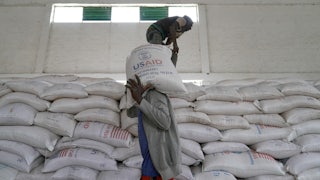“Haitians like goat. That’s the meat for Haitians.”
Romane Pierre, the manager of Rose Goute Creole Restaurant in Springfield, Ohio, looked tired but happy as he rushed to take orders from customers. The most popular item on the menu, he said with a grin, was rice and beans with goat. It was supposed to be Pierre’s day off, but the Haitian eatery had seen a huge increase in business in the days after the national spotlight turned its focus on Springfield.
The story, which you’d need to be from Mars not to know by now, began in early September, when rumors popped up on social media that Haitian immigrants in the small Ohio city were stealing and eating pets. The rumors gained traction when former President Donald Trump referred to them during the presidential debate with Vice President Kamala Harris. Trump’s running mate, Ohio Senator J.D. Vance, continued to spread the lie, even as Vance’s constituents in Springfield became the target of dozens of bomb threats, prompting schools and government offices to close or switch to doing business online.
But in an aging (albeit recently resurgent) retail strip center in south Springfield anchored by a Family Dollar store, Rose Goute Creole was open for business. Even though it was a weekday afternoon, at a time when the staff normally would have been refilling napkin dispensers and preparing for the dinner rush, the place was almost half-full with diners.
Jim and Jackie Shulman had driven over from their home in Columbus to visit Springfield’s history museum and had decided to stop into the restaurant, which itself has been the focus of social media posts. Photos online showing crowds lining up to get plates of Haitian food had piqued their interest.
Before those social media posts about Rose Goute Creole appeared, “we didn’t even know it existed,” Jim Shulman said. “I think it’s great.”
He smiled broadly as his wife packed up several to-go cartons. Rose Goute Creole serves enormous portions, and most diners followed the Shulmans’ example and took home leftovers.
That included a couple sitting at the table next to the Shulmans.
Jeffrey Tilley and Coretta Thomas, from the Dayton suburb of Huber Heights, “heard all the rhetoric,” Tilley said. “So we decided to do our part and spread the love. And the first thing you know, we run into some good people,” he said, nodding to the Shulmans.
“I feel sorry for people who are missing out on some good food,” Thomas said. “We are definitely coming back. We usually go to Los Mariachis, but now we have a couple places.”
Ohioans often joke that the South doesn’t begin below the Mason-Dixon line—it actually begins below Interstate 70, the east-west highway that neatly bisects the state, running straight through the centrally located capital city, Columbus.
They’re not entirely joking. Drive less than an hour east from Columbus, and less than an hour west along the interstate, and remnants of the South and its violent, racist past manifest themselves in surprising ways.
To the east of Columbus is Buckeye Lake. Built in the early nineteenth century as a reservoir for the Ohio Canal, the lake became a recreational area in those days for vacationing Ohioans—including members of the Ku Klux Klan, which had experienced a revival in the early twentieth century. Buckeye Lake was so popular with the Klan that the once-thriving interurban rail line ran special cars to transport Klansmen and their families to the area. The “Grand Dragon” of the Indiana Klan, D.C. Stephenson, even had a summer home at Buckeye Lake, and under his leadership in 1925 the Klan held a gathering billed as the “largest Konclave in the United States,” with an estimated 75,000 white-robed Klansmen in attendance. (This was just before he viciously raped and murdered a young woman who worked on an adult literacy program.)
While the lake’s past as a Klan haven is forgotten among many Ohioans, the place remains 97 percent white, according to the 2020 census.
To the west of Columbus, meanwhile, is Springfield. There, a home built in 1850—the Gammon House, after owners George and Sarah Gammon—played a crucial role during the Civil War as a stop on the Underground Railroad. While some runaway slaves continued north, others set down roots in and around the Springfield area, which over the decades has held some important distinctions in the Black community. In 1875, Springfield-based Wittenberg University admitted its first Black student. Less than 20 miles south of the city is Wilberforce University, founded in 1856 as the nation’s first private historically Black university. Near to that school is the National Afro-American Museum and Cultural Center. And in 1966, Springfield’s City Commission appointed Robert Henry as the first Black mayor in Ohio.
Even so, Springfield has hardly been without racial conflict.
In March 1904, a mob of white residents stormed the jail and seized Richard Dixon, a Black man accused of killing a police officer. The mob killed Dixon, strung up his body from a pole and continued shooting the corpse, then destroyed and burned Black neighborhoods in the city. Two years later, an altercation between a white man and a Black man sparked another riot, with a white mob burning down a significant portion of a Black neighborhood.
With such a fraught history, then, it seems almost inevitable that a self-described hillbilly who grew up in the South—or rather, south of I-70, about 50 miles outside of Springfield—would break out a rhetorical noose and string up an unsuspecting group of Black migrants who, much like their predecessors during the Civil War, simply sought refuge and work in a small Ohio city.
It’s important to note that Haitians were invited to come to Springfield. In 2014, the city began its “Welcome Springfield” initiative to attract newcomers to replenish its dwindling population.
But while most Haitians in the United States live in Florida or the Northeast, the small population of Springfield—just over 58,000 in 2022—means that even a few thousand newcomers are noticeable and have put a strain on the community’s social services.
Rose Goute Creole opened last year in Springfield to serve the influx of Haitian immigrants. Wedged between a Latin Market and a Beauty Depot in a retail strip that could be in any neighborhood in America that has seen its share of ups and downs, Rose Goute quickly gained a good reputation, with online reviews giving it top ratings for “Best Caribbean food.”
A few days after bomb threats shut down many schools and government offices, Ohio Governor Mike DeWine talked about the important role that Haitians are playing in Springfield’s efforts to rebuild from a long decline.
“Springfield has really made a great resurgence with a lot of companies coming in,” DeWine said in an interview with ABC News. “These Haitians came in to work for these companies. What the companies tell us is that they are very good workers. They’re very happy to have them there. And frankly, that’s helped the economy now.”
Those hard-working Haitians clearly include the Rose Goute Creole staff. As Pierre shuttled in and out of the kitchen, placing orders and picking up trays to deliver to the sit-down dining crowd, he spoke in Haitian Creole to customers waiting to pick up bags of carry-out meals.
A few feet away, Scott Roderick and his wife, Kelly Kight, were just beginning to dig into the food piled high on their plates.
“I was here with my brother Dave when it opened about a year ago,” Roderick said. “We had read about it. Dave and I—he’s a vegetarian, so he’s always on the lookout for a new place.” He continued: “Kelly and I are very adventurous eaters. We live about five miles south of here, and after Dave and I checked it out, I said to Kelly, ‘We’ve got to go back.’”
Looking around at the other diners, he added, “I’m glad to see we’re not the only ones with a brilliant idea” to stop in for a meal.
“We’ve lived in Springfield about eight years now, and I remember there was a Kroger” in the shopping strip. “This part of south Springfield was a food desert until about five years ago. I think Springfield has done a good job bringing this area back.”
While the nasty headlines swirl around them, Springfielders and Ohioans are making a point of saying no to Trump and Vance’s toxic message—and making Romane Pierre work overtime. When asked if business has been good since the restaurant became a cause célèbre, he stopped his perpetual motion for a brief moment, sighed, and shook his head: “Oh yeah. Oh yeah. Very, very good business.”






